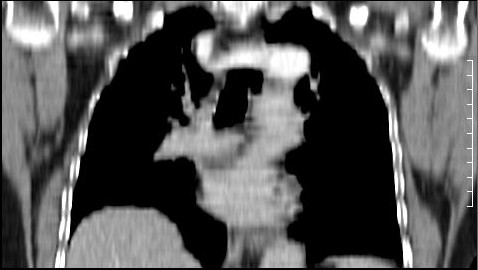Dysphagia lusoria. A case presentation
Keywords:
deglutition disorders/diagnosis, subclavian artery/ultrasonographyAbstract
Introduction: dysphagia lusoria is an infrequent cause of mechanical dysphagia caused by extrinsic compression.
Clinical case: it was studied a patient admitted because a dysphagia with clinical suspect of esophageal neoplasm. An esophagogram was performed, patient was not collaborative, it was not possible to opacify esophagus in its whole extension, it was observed a defect of irregular fullness in its third superior suggesting esophageal neoplasm. It was decided to confirm diagnosis using endoscopy of high digestive way. There was no observation of lesions at esophagus level, but the presence of chronic gastroduodenitis signs and mild gastroesophagic reflux. Because of the controversial results in both studies and patient symptoms, a contrasted tomography of mediastinum was performed.
Discussion: the presence of an anomalous vessel at the level of the aortic arch measuring 17,89 mm in the right, posterior to esophagus compressed esophagus and moved it to the front and to the right. In multiplanar reconstruction corresponds to a right aberrant subclavian artery.
Conclusion: dysphagia lusoria is the most frequent anomaly in the development of the aortic arch. These aberrant arteries tend to dilate and can be complicate with thromboembolic phenomena in the right superior extremities or with rupture. Besides, it can be associated to other alterations of the development of the aortic arch or with the descendent aorta, as an aortic coarctation.
Downloads
References
1. Aviñoa Arreal L. Disfagia lusoria. Rev Esp Enfer Dig (Madrid) [Internet]. 2008 [citado 15 Ene 2016]; 100(11):730-8. Disponible en: http://scielo.isciii.es/pdf/diges/v100n11/carta6.pdf.
2. Muñoz A, Obregón J, Salej JE, Jiménez JM. Disfagia lusoria: reporte de un caso y revisión de literatura. Rev Col Gastroenterol [Internet]. 2009 [citado 15 Ene 2016]; 24 (4):396-402. Disponible en: http://www.scielo.org.co/pdf/rcg/v24n4/v24n4a10.pdf.
3. Febrero B. Disfagia lusoria como diagnóstico diferencial de la disfagia intermitente. Gastroenterol Hepatol [Internet]. 2016 [citado 15 Ene 2016]; (3). Disponible en: https://www.researchgate.net/profile/Beatriz_Febrero/publication/301505623_Disfagia_lusoria_como_diagnostico_diferencial_de_la_disfagia_intermitente/links/57d7d58308ae601b39aeeae7.pdf.
4. González Sánchez M, Pardal Refoyo JL, Martín Sánchez A. Arteria subclavia derecha aberrante y disfagia lusoria. Acta Otorrinolaringol 2013; 64(3):244-5.
5. Venugopal RR, J Premanand Kolwalkar J, Putane Krishnajirao S, Narayan M. A novel approach for the treatment of dysphagia lusoria. European J Cardio-Thoracic Surg[Internet]. 2013 [citado 16 Ene 2016]; 43: 434-6. Disponible en: https://academic.oup.com/ejcts/article/43/2/434/469023/A-novel-approach-for-the-treatment-of-dysphagia.
6. Thompson JL, Burkhart HM. Translocation of an Aberrant Right Subclavian artery With Resolution of Dysphagia Lusoria. Ann Thorac Surg. 2016; 102(1):65–7.
7. Araujo G. de, Junqueira Bizzi JW, Muller J, Totti Cavazzola L. “Dysphagia lusoria” – Right subclavian retroesophageal artery causing intermitent esophageal compression and eventual dysphagia – A case report and literature review. Int J Surg Case Rep [Internet]. 2015 [citado 16 Ene 2016]; 10: 32–4. Disponible en: https://www.ncbi.nlm.nih.gov/pmc/articles/PMC4429950/.
8. Martinez JD, Maya LF, Gómez M, Lizarazo J, Rey MH, Garzón M, et al. Dysphagia Lusoria y Diverticulum de Zenker. Reporte de caso. Rev Fac Med [Internet]. 2014 Jan [citado 20 Ene 2016]; 62(1): 131-5. Disponible en: http://www.scielo.org.co/pdf/rfmun/v62n1/v62n1a16.pdf.
9. Algieri RD, Mazzoglio Nabar MJ, Ferrante María S. Variación Retroesofágica del Arco Aórtico. Int J Morphol [Internet]. 2008 Jun [citado 20 Ene 2016]; 26(2): 337-43. Disponible en: http://www.scielo.cl/scielo.php?script=sci_arttext&pid=S0717-95022008000200015&lng=pt. http://dx.doi.org/10.4067/S0717-95022008000200015.

Published
How to Cite
Issue
Section
License
Avisos de derechos de autor propuestos por Creative Commons
1. Política propuesta para revistas que ofrecen acceso abierto
Aquellos autores/as que tengan publicaciones con esta revista, aceptan los términos siguientes:- Los autores/as conservarán sus derechos de autor y garantizarán a la revista el derecho de primera publicación de su obra, el cuál estará simultáneamente sujeto a la Licencia de reconocimiento de Creative Commons que permite a terceros compartir la obra siempre que se indique su autor y su primera publicación esta revista.
- Los autores/as podrán adoptar otros acuerdos de licencia no exclusiva de distribución de la versión de la obra publicada (p. ej.: depositarla en un archivo telemático institucional o publicarla en un volumen monográfico) siempre que se indique la publicación inicial en esta revista.
- Se permite y recomienda a los autores/as difundir su obra a través de Internet (p. ej.: en archivos telemáticos institucionales o en su página web) antes y durante el proceso de envío, lo cual puede producir intercambios interesantes y aumentar las citas de la obra publicada. (Véase El efecto del acceso abierto).






